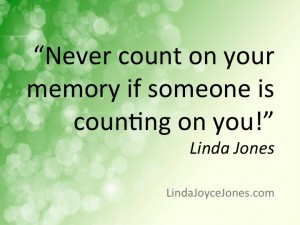I love the time of year when calendars and planners hit the shelves. Each year the selection grows as manufacturers try to help us find a way to organize the chaos of our lives. Wall calendars with pictures of adorable puppies or breathtaking landscapes, niche-planners for moms or students, and leather-bound executive planners with every imaginable customized insert – oh, how to choose! Big enough to record appointments, meetings, kid stuff and work deadlines, but not so big that it is cumbersome to tote around.
Whatever you decide to use, you should plan to spend at least 5-15 minutes each day maintaining a calendar and task list. Spend this time reviewing your calendar for the next week, adding any appointments, to-do items, or reminders. Reminders are simple notes that you should put in your calendar prior to an event (i.e. entering a reminder on Tuesday to purchase a gift for the birthday party on Saturday). Just move backward from the date of the event and put in that little memory-jogger to avoid scrambling at the last minute. Use the reminder tools on your online calendars to help you remember that your dad’s birthday is the first of the month, or that your contribution to the company blog is due in ten days, or that you need to make arrangements for the kids while you are at the doctor after work next Thursday.
There are dozens of ways to keep track of your schedule. If you’re like me, you’ve tried various methods at one point or another. Some systems work better than other depending on the stage of your life and how many different schedules you’re trying to keep track of. If you’re tracking work, home, kids, and community activities, you may require something with a little more flexibility and writing room. But if you’re a student trying to keep track of assignment due dates, the calendar feature on your cell phone may be all you need.
Review these common scheduling systems to find the one that suits you:
1) Wall or refrigerator calendar – typically month-to-a-page
Pros – highly visible to others; Cons – lack of portability, limited writing space
2) Pocket calendar – typically month-to-a-page
Pros – very portable, it takes up virtually no space in a purse or pocket; Cons– writing space is very restricted
3) Planners – these systems use either 8 ½ x 11 or 8 ½ x 5 ½ sheets; they are typically either month-to-a-page, week-to-a-page, or day-to-a-page.
Pros – extremely versatile, as companies provide versions for different demographics (student, busy mom, professional, etc.) that have customized pages; Cons – can be quite bulky and difficult to maintain; can also be a little pricey if you spring for all the extras
4) Online systems such as Google Calendars or Microsoft Outlook provide multiple ways to view your calendar, and get reminders sent to your email or smart phone.
Pros – ability to create recurring events, easy to learn; Cons – must have connectivity in order to view it from work and home
5) Telephone Calendar – virtually every cell phone now has an imbedded calendar function. Also check out the calendar and planning apps for your smart phone, such as Cozi or PocketLife.
Pros – nothing extra to carry around, always available to view or modify – great for keeping a personal schedule, includes a built-in reminder feature; Cons – if you don’t have mad texting skills, entering events can get pretty tedious.
6) Project management software – Under certain circumstances, a tool such as Microsoft Project may be necessary to keep track of a complicated, extended endeavor.
7) Printable Calendar Pages – If you find yourself copying appointments to multiple calendars, its time to rethink your system. If you’re not sure what’s right for you, I recommend that you buy a simple 1/2-inch three-ring binder and use the FREE PRINTABLE CALENDAR I created that provides tons of space for tracking appointments, goals, meal plans and to-do’s. Out of all of the methods I have tried, this is the best tool I have found to manually keep track of a schedule and tasks. Unless you’re a doctor scheduling appointments on the quarter-hour, this size is probably big enough to keep track of work, home, and volunteer schedules, but small enough to easily transport wherever you go. Never count on your memory if someone else is counting on you!
Next – Applying Project Management Principles to Event Planning
Want to start at page 1 of this book blog? Click here

If you’d like a tool for managing your time and projects, you can use this web-application inspired by David Allen’s GTD:
http://www.Gtdagenda.com
You can use it to manage your goals, projects and tasks, set next actions and contexts, use checklists, and a calendar.
Syncs with Evernote and Google Calendar, and also comes with mobile version, and Android and iPhone apps.
Thanks for the suggestion!